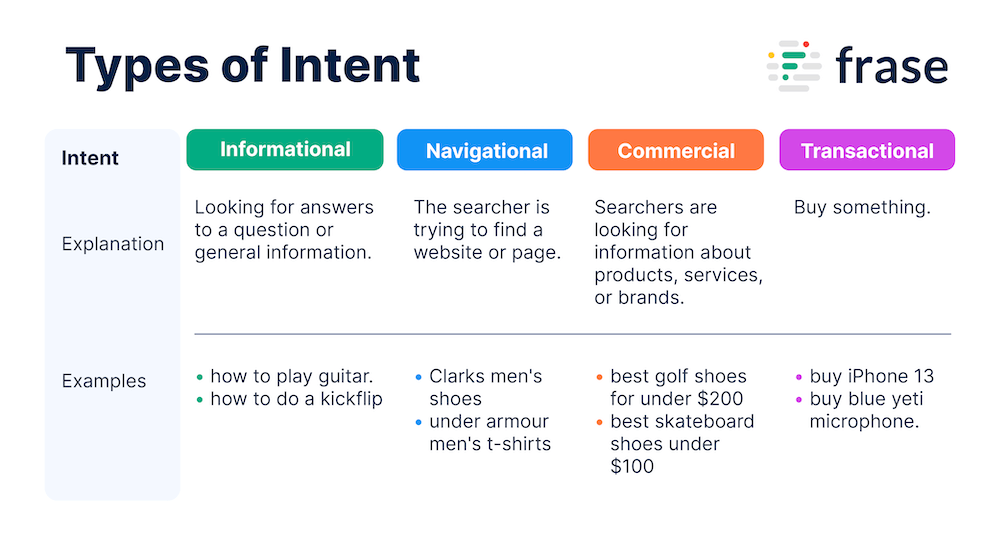Index Surge: Amplifying Your Insights
Stay updated with the latest trends and news across various industries.
Search Intent Decoded: What Are They Really Looking For?
Unlock the secrets of search intent! Discover what users truly seek and boost your content strategy for maximum impact.
Understanding the Four Types of Search Intent: A Comprehensive Guide
Understanding search intent is crucial for optimizing your content for SEO. There are four primary types of search intent: navigational, informational, transactional, and commercial investigation. Each type serves a different purpose for users. For example, navigational intent occurs when users are looking for a specific website, such as typing in 'Facebook' to access the social media platform directly. In contrast, informational intent is characterized by users seeking knowledge or answers to questions, such as searching for 'how to bake a cake'. Knowing these intents can guide you in crafting content that meets your audience's needs.
On the other hand, transactional intent refers to users who are ready to make a purchase, indicating a clear intent to buy. Keywords associated with this intent often include terms like 'buy', 'discount', or 'purchase'. Lastly, commercial investigation involves users comparing products or services before making a final decision, often using search queries like 'best laptops 2023' or 'iPhone vs Samsung.' By understanding these four types of search intent, you can tailor your content strategy to improve engagement, drive traffic, and ultimately boost conversions on your site.

How to Align Your Content with User Search Intent for Better Engagement
Understanding user search intent is crucial for creating content that resonates with your audience. Start by analyzing the keywords that users are searching for and categorizing them into four main types: informational, navigational, transactional, and commercial investigation. For example, if a user types 'how to align content with user search intent,' they are likely seeking informational content that provides insights or strategies. By aligning your content to meet these needs, you can significantly enhance user engagement and satisfaction.
To effectively align your content with user search intent, consider the following steps:
- Research Keywords: Utilize tools like Google Keyword Planner or SEMrush to identify relevant keywords.
- Understand Audience Needs: Create user personas and map out their pain points.
- Craft Targeted Content: Develop content that specifically addresses the identified search intent.
- Optimize for SEO: Ensure your meta titles, descriptions, and headings reflect the targeted keywords and intent.
What Questions Are Users Really Asking? Unraveling the Mystery of Search Intent
Understanding search intent is crucial for any content creator aiming to optimize their blog for SEO. When users type a query into a search engine, they are often seeking specific information, answers to questions, or solutions to problems. To unravel this mystery, we must first categorize search intent into three main types: informational, navigational, and transactional. For example, users searching for 'how to start a blog' generally have an informational intent, whereas someone searching for 'buy running shoes online' exhibits transactional intent. By identifying the underlying intent behind popular queries, content creators can tailor their articles to meet user needs more effectively.
Moreover, addressing user questions is not only about providing information but also about engaging them throughout their journey. Tools such as Google's People Also Ask and keyword research platforms can help uncover the most pressing questions users have related to your niche. By analyzing these questions, bloggers can create authoritative content that directly answers user inquiries, thereby enhancing their chances of ranking higher on search engine results pages (SERPs). In conclusion, acknowledging what questions users are really asking allows content creators to deliver targeted, relevant, and valuable insights that resonate with their audience.